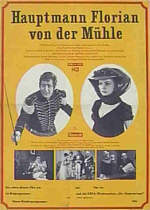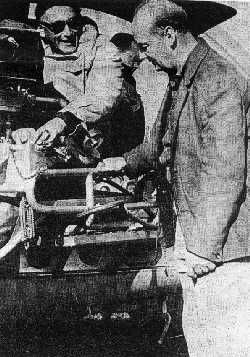Looking for DEFA 70 |
This article first appeared in |
| Written by: Ingolf Vonau, Berlin, Germany | Issue 58 - September 1999 |
|
|
Further in 70mm reading: |
 It
was Andrew Thorndike's idea to introduce 70mm in East-Germany. He was the
son of Andrew Thorndike III., a major share-holder of the UFA studios and
the most important man around the media crew of Alfred Hugenberg in the
Weimar Republic. Andrew Thorndike came from the upper middle class. He was
general representative for the UFA-Advertising-Film during the 1930s and
later cultural and
industrial-director (in the sense of an art-director for cultural and
industrial films). Imprisoned because of suspicion of “undermining
defence-power” in 1942 and survivor of the war at the east-front as an
ambulance man, he came back to Germany after four years of being POW in
Russia. He became DEFA´s most famous and important documentary director and
developed into a passionate and thoroughly convinced propagandist for the
eastern world-view. Together with his wife Annelie, he filmed political
documentaries that were shown in a lot of countries but encountered mostly
rejection in West Germany. It
was Andrew Thorndike's idea to introduce 70mm in East-Germany. He was the
son of Andrew Thorndike III., a major share-holder of the UFA studios and
the most important man around the media crew of Alfred Hugenberg in the
Weimar Republic. Andrew Thorndike came from the upper middle class. He was
general representative for the UFA-Advertising-Film during the 1930s and
later cultural and
industrial-director (in the sense of an art-director for cultural and
industrial films). Imprisoned because of suspicion of “undermining
defence-power” in 1942 and survivor of the war at the east-front as an
ambulance man, he came back to Germany after four years of being POW in
Russia. He became DEFA´s most famous and important documentary director and
developed into a passionate and thoroughly convinced propagandist for the
eastern world-view. Together with his wife Annelie, he filmed political
documentaries that were shown in a lot of countries but encountered mostly
rejection in West Germany.Open-minded for technical improvements, and Russian experiments with 70mm wide-screen of the late 50s were made available to him. It was clear to him that if cinema were to have a chance for mass communication it would have to develop an improved form of presentation. And this was only possible with 70mm. Because of his acquaintance with head-of-state Walter Ulbricht he spoke up for starting East German 70mm production. That included the construction of a new 70mm studio camera and acquisition of Russian 70mm cameras as well, filming with 70mm ORWO raw stock, development of printing technology, construction of a six channel sound stage, and construction of own universal projectors for re-equipping cinemas or building new ones. Please understand, it's very hard to get into contact with people who really know the facts about the DEFA 70 story. Either they have objections towards my research, don't return my calls or they are just “unavailable”. I never had contact with decision makers before, but somehow these people have a problem with their past. The DEFA 70 story is after all a political story. That goes with the system. It was, for example, possible for me (after being introduced) to talk to a man who held a position as economist in DEFA's head office. He bought Kodak film material for the GDR, including 70mm stock. He told me not to mention his name to anyone. Now, if that isn't nuts! |
|
 Picture
from the press book. Picture
from the press book.I managed to establish contact with Annelie Thorndike, and interview her. This is not as easily possible for the Federal Archive because Mrs. Thorndike is being harassed politically from various people and she naturally avoids having contact with them. She and her late husband, Andrew Thorndike, definitely belong among the most important documentary film makers of Eastern Europe. Their film “The Russian Wonder” alone, was shown in 80 countries. Briefly, the film “Du bist min - Ein deutsches Tagebuch” was the most expensive and large-scale documentary film-project of DEFA. And yet it only constitutes a small part to the most comprehensive 70mm project: to create a film about the German history. This project was known by the name “Germania und ihre Kinder” (“Germany and her Children”) but was later renamed into “Die Deutschen” (“The Germans”), a 70mm documentary film in two parts, filmed at the most important cultural sites of both East- and West Germany. This film was finished in the summer of 1968 but was never shown in public. The film was subsequently cut, torn apart and released later with a completely different intention under the title “Du bist min - Ein deutsches Tagebuch”. That is the interesting story I came across. It was not known in German film history that a project existed that was filmed with 70mm in East- and West Germany, that produced excellent aerial photographs with a stabilized camera (like Steadicam later did). The footage was later destroyed and only certain reels survived in a secret air-raid bunker located on the Babelsberger film site. These reels are now stored in the Federal Archive for restoration after some people criminally damaged them while these reels were in interim storage. Andrew Thorndike died in 1979. When I visited his wife she told me that she'd never thought anybody would be interested in 70mm after 38 years. Her husband, at that time, was always walking back and forth in the upper story of the house, saying “Todd-AO, that is what we need”. I hope to tell the full DEFA 70 story in a future ..in 70mm – The 70mm Newsletter. |
|
|
Go: back
- top - back issues Updated 22-01-25 |

